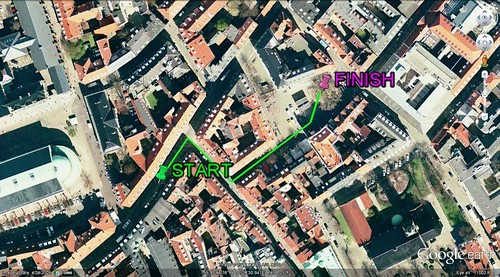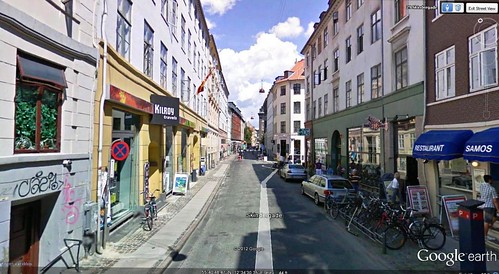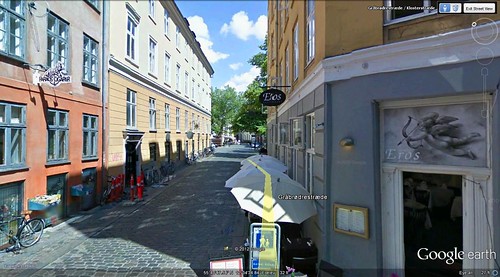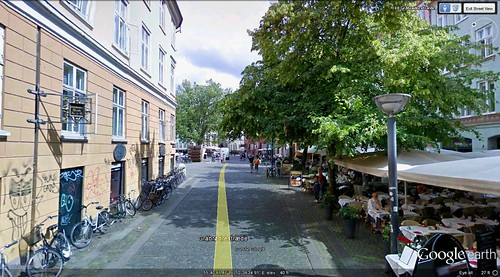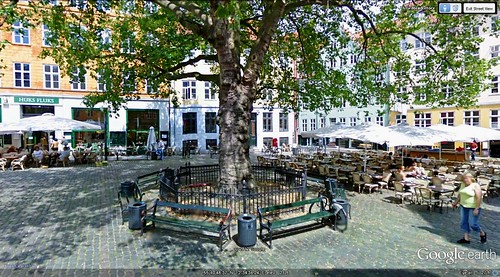A short walk reveals the simple delights of cities worth loving

Posted May 22, 2012 at 1:28PM
Phil LaCombe and Lou Thomas, co-founders of the website and blog Small Streets, believe that the Danish capital of Copenhagen provides a special environment for delightful walking. It is certainly not a shock to find such praise for the city that practially invented the concept of the modern, car-free shopping street, and that is the home residence of Jan Gehl, perhaps the world's most celebrated planner of humanist streets and public spaces. But it is still a treat to run across an illustrated "virtual tour" of some of the reasons why.
That's exactly what the authors offer to us in a blog post published last week. Using Google Earth's Street View feature, they take us on a short walk, only about two blocks in length, that is full of great people-scaled urbanism, exactly the kind of fine-grained diversity that I wrote about in yesterday's post. I went to Google Earth and "traveled" the same route in order to whet your appetite. But go to the original for more explanation.
The walk starts on the Skindergade, traveling northeast. Notice all the bikes on the right-hand side.
A quick right heads us down a somewhat narrower street called Klosterstraede. Notice how the street light hangs from the center, obviating poles that can block sidewalks. Also notice the different colors and building textures.
A quick left and we're headed down the cobblestoned, almost unwritable Grabrodestraede. Little cafes are starting to appear, and there's greenery in the distance.
Speaking of greenery, as we near a small square, shaded cafes appear on the right, more bikes on the left. It looks a heck of a lot more pleasant than the places I've been grabbing lunch lately.
The square itself is anchored by a single tree in the center, surrounded by benches and more cafes. Small Streets says it's only about a half-acre, but it's quite abviously enough to create a sense of place, somewhere we want to be to relax and enjoy a drink, meal and conversation.
This is all rather simple, and Small Streets presents it in a more engaging fashion tnan I do here. But simplicity is kind of the point. The amount of density and building stock is just enough to entice and relax without creating a feeling of being overwhelmed or crowded. I would love to have more spaces like this in my own city.
It's not a coincidence that older neighborhoods built before the dominance of cars in the late-20th century sometimes provide the kinds of places people love most. The word love is deliberately chosen. In order to conserve the natural and working landscape outside of cities, in order to create places where people enjoy walking and, when they need to drive, don't have to drive far -- all of which benefit the natrural environment -- we need the kinds of cities that are worth loving.
From the Small Streets website:
"For centuries, small streets [defined as no wider than 30 feet] served an integral role in our cities and towns. They provided intimate and nurturing spaces for families within walking distance of daily needs. Small streets added beauty and wonder to our neighborhoods . . .
"In the 20th century, zoning and fire codes prioritized the car above all other modes of transportation, especially walking. We have outlawed small streets, and in the process lost an essential element of our cities and towns.
"Small Streets advocates for a return of the balanced city, focused on preserving our historic small streets and reintroducing new small streets to our communities."
We need our wide thoroughfares, too, of course. But, if I could have streets like these in Copenhagen, I'm not sure I would use the wide ones much.
Related posts:
- Is placemaking a "new environmentalism"? (April 23, 2012)
- The importance of place to sustainability (July 12, 2011)
- Accommodating the multiple purposes of streets (video) (January 28, 2011)
- Resource: making cities "livable and lovable" (April 21, 2011)
- Seeing cities as the environmental solution, not the problem (August 9, 2011)
Move your cursor over the images for credit information.
Please also visit NRDC’s Sustainable Communities Video Channel.
